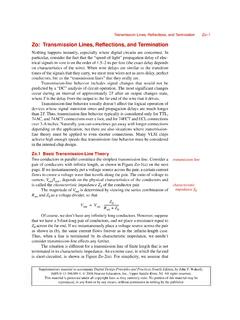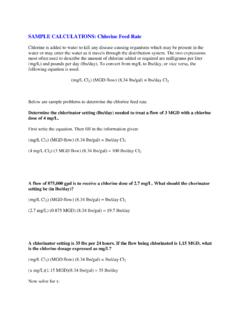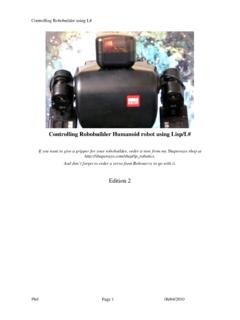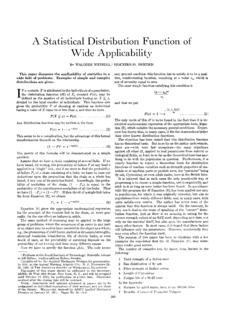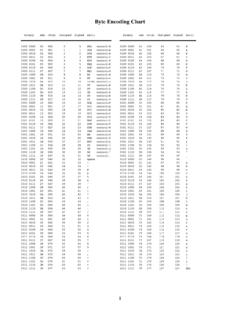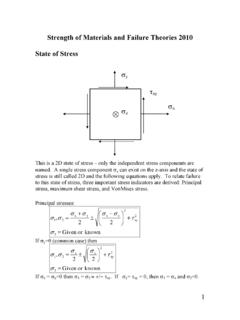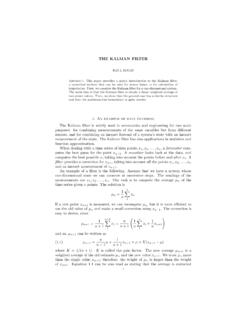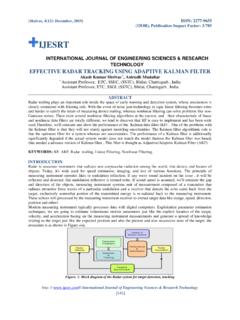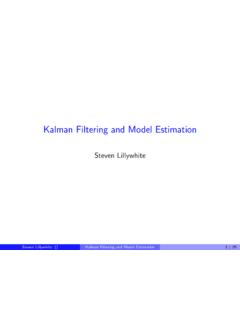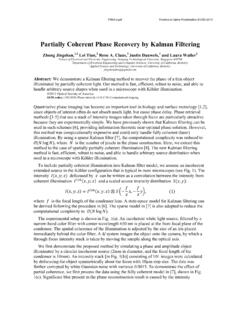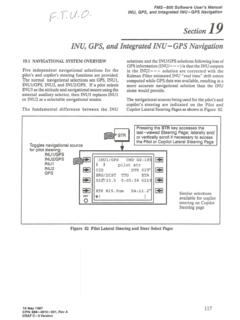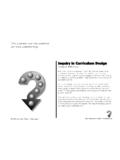Transcription of The FPGA Implementation Of Kalma2 - Computer Action Team
1 The FPGA Implementation Of kalman Filter GANG CHEN and LI GUO Department of Electronic Science and Technology University of Science & Technology of China CHINA Abstract: - Based on the fact that Faddeev s algorithm can be easily mapped into the Systolic array for im-plementing. An FPGA Implementation of kalman Filter using Modified Faddeev [1] is proposed The Modi-fied Faddeev uses Neighbor pivoting for triangularization substituting the Gaussian elimination may cause the overflow of the datas, and Neighbor pivoting can guarantee the stability of data stream.
2 Moreover due to apply the technology of resource sharing, we use one trapezoidal array instead of bitrapezoidal array [2], thus reducing the silicon area. Techniques employed for data skewing and storage organization are efficient, then reducing the complexity of control and increasing the speed of computation. KeyWords: - FPGA, kalman filter, Modified Faddeev s algorithm, Systolic array, Implemantation 1 Introduction Since the kalman filter [3] was introduced by in 1960, it has been widely used in the areas of modern control, signal processing,air-borne control systems, adaptive controls, radar signal proc-essing, missile control, and on-board calibration of inertial systems.
3 Being an optimal recursive estima-tor, kalman filter provides a real-time algorithm to estimate the unknown state vector recursively for each measurement based on minimization of the mean squre error, which is a measurement of the quality of noisy data processing. Direct implementa-tion of the kalman filtering algorithm is not efficient, because of its computational complexity , which in-volves many matrix multiplications and inversions. Based on the fact that Faddeev s algorithm can be easily mapped into the Systolic array for implement-ing [4].
4 Many authors have implemented the kalman Filter directly using Faddeev s algorithm [5][6]. In this paper, an efficient systolic implementa-tion of the kalman filtering problem using the Modi-fied Faddeev s algorithm and one trapezoidal array is presented. In our proposed implemementation, the Modified Faddeev s algorithm is used through Neighbor pivoting for triangularization substituting the Gaussian elimination, which guarantees the sta-bility of data stream, also, the technology of sharing resource is appled in designing cell to reducing the silicon aeras.
5 2 kalman filtering problem kalman filter is an optimal linear estimator which provide the estimation of signals in noise. kalman used the state transition models for dynamic system. kalman filter equations can be sloved numerically by using a recursive type structure whose outputs only depend on the current inputs and current states (pre-vious output). The system and measurement model equations are: State equation )1()()(),1()1( ++ =+kwkXkkkX Measurement equation )2()()()()( +=kVkXkHkY Where )1(+kX=[])()()()(4321 KXKXKXKX )(kY=[])()(21 KYKY Proceedings of the 5th WSEAS Int.
6 Conf. on Signal Processing, Computational Geometry & Artificial Vision, Malta, September 15-17, 2005 (pp61-65) W(k) is dicrete white noise serial, and EW k W k jT[() ( )]+=0. V(k) is the measurement noise, and they are assumed to be white Gaussian noise. The optimal estimate)( kXbased on minimum covariance is given by the following set of Equa-tions: )4()()()1|1( )1,()1|( + = kakUkkXkkkkX [])5()()()1|()()()1|()(1 + = kRkHkkPkHkHkkPkKTT )6()1()1,()1|1()1,()1|( + = kQkkkkPkkkkPT [])7()1|()()()|( =kkPkHkKIkkP Where R and Q are the covariance matrices of observation and system noises, respectively.
7 0( X )0(P are known initially. 3 The implement of kalman Filter Faddeev s algorithm Consider a matrix F as following : Where A,B,C,D are matrices , and Faddeev s algorithm does the following s linear transformation: If 1 =CAW, then the lower left-hand side are zeros, then D+WB =BCAD1 + is the desired output, appearing in the bottom right-hand quadrant after the process to annul the bottom left-hand quadrant. By selecting appropriate valves for A,B,C,D in compound matrix E ,a systolic standard kalman fil-ter can be implement.)
8 Then through analyzing the equations (3) (4), Table 2 defines data required for the computation of kalman filter [7]. Faddeev s algorithm mapped onto Sys-tolic array [8] We used the trapezoidal array illustrated in [4] to implement the Faddeev s algorithm. If the input matrix is 2*n rank, then the Systolic array is maked up of sub-array T and sub-array S , which including n*(n-1)/2 PE and n*(n-1)/2 PE, respectively. There are two types of PE : square and circular PE. As shown in the , the elements of matrix A are firstly fed to the sub-array T, and B are fed to sub-array S, and both of them are fed to the array in a skewed way as shown in This skewing can be achieved through delay cells.
9 The elements of matrix A are triangularized in the sub-array T, then being stored in the PE of sub-array T. At the same time, the multiplier M is fed to the right-hand sub-array S, and the same row elements of B make the same transformation, storing in the PE of sub-array S. The column elements of matrix C are fed into sub-array T after the matrix A, after the transformation , all the elements of matric C are ze-ros, and at the same time, the multiplier M is fed to the right-hand sub-array S.
10 And the same row ele-ments of D make the same transform after the transform, the desired result matrix E are out through the bottom of the sub-array S [4]. The data input is in a skewed way, then finish the triangularization and elimination. The trapezoidal array for solving four-state standard kalman filter has 26 processing cells including 4 boundary cells and 22 internal cells. The processing elements have been specially designed and implemented, which will be illustrated in the following charter.


